THE BIOPOLITICAL MILITANCY OF JOAQUIM JORDÀ
Carles Guerra
 FORWARD
FORWARD
 DOWNLOAD
DOWNLOAD
 ABSTRACT / KEYWORDS / ARTICLE / BIBLIOGRAPHY / ABOUT THE AUTHOR
ABSTRACT / KEYWORDS / ARTICLE / BIBLIOGRAPHY / ABOUT THE AUTHOR
Joaquín Jordá’s filmography suffers from an unusual heterogeneity of styles and formats. Despite documentary would be the most accurate classification for his films, a specific conflict and a singular process that challenges the genre dwells in each of his titles. Neither have the multiplicity of practices associated to his activity as a filmmaker contributed to facilitate a portrayal of his work. His last years as a teacher, the militancy in the beginning of his career, as well as a dilated screenplay production and some translations, constitute an intellectual profile that overreaches the notion of author. Despite the long time in between his first and his last movie (forty six years between 1960 and 2006), his filmography is rather scarce. Besides, there is an alarming precariousness in what refers to the preservation of some of his films and a general difficulty to their access. The proof relies on the fact that, even eight years after his death, we are still missing a critical analysis that encompasses his contributions1. Nevertheless, Jordá’s validity is undeniable. The effects of his work are perceived periodically.
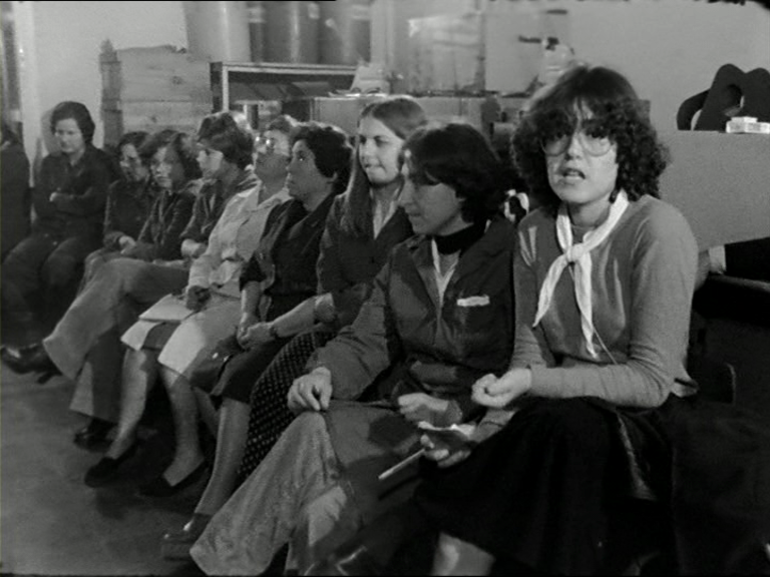
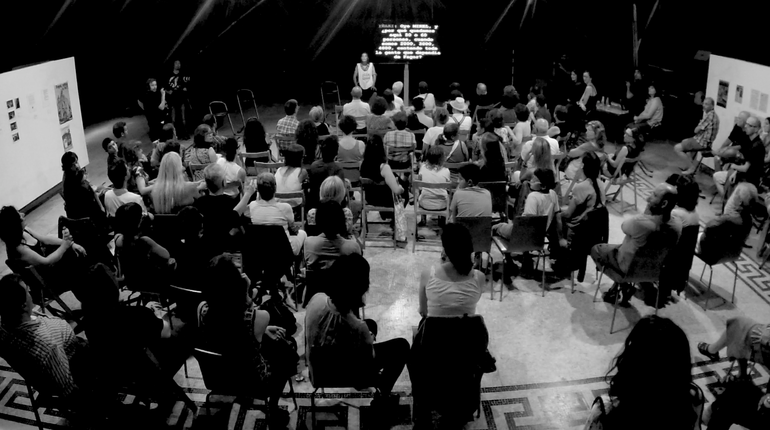
Bottom: Numax-Fagor-Plus (Roger Bernat, 2014)
Among his filmography, Numax presenta… (1979) stands out for being a documentary film with a significant series of revivals. The most recent one was that of Roger Bernat, who staged the dialogues of the movie regarding the current crisis2. Numax presenta… does not even require to be projected in order to keep evoking its potential, and it gets to spread through other media, in this case, a theatrical device. The staging of the film achieves to revive the words of the workers, filmed in 1979, among the spectators of Roger Bernat’s new play. Thus, despite the film is a militant document connected to a specific event, it suggests an extended use of value. The film has catalysed a succession of audiences from the first projections until the last versions and reappropriations of the text. The specificity of the conflict represented in Numax presenta… has not been an obstacle for the film to unfold consecutive readings in different contexts. The strike and the self-management process leaded by the workers of the Numax enterprise during the transition to democracy, have found and explicit echo in following moments. The original document has been constantly reanimated: from the anti-globalisation mobilisation and the post-fordist background that criticized the production models of capitalism at the end of the 20th century, to the most recent breakdown of the financial crisis.
One of the main reasons to focus our attention on this film is the fact that it can represent the transition between a classical militancy –which is the base for Numax presenta…– and one of a biopolitical order that would be related to works such as Monkeys like Becky (Mones com la Becky, 1999) and De nens (2003). This transition will help to determine Joaquín Jordá’s portrayal better than any periodization. Numax strike broke with the orthodoxy of labour and syndicalist militancy, to the point that its conclusion proclaimed the abolition of salaried work. Jordá resumed the self-management experience of the workers between 1977 and 1979, through the recreation of the assemblies that one after another fill the film with a strongly discursive feature. The in extremis incursion of a debate that declared the factory labour obsolete, were in tune with the aspirations of the Italian autonomism. Thus, Numax presenta… was articulating something bigger than the testimonies of some workers: the dismantling of that appliance factory in the Barcelonan Eixample would become a symbol of a new productive model3 with time. Nevertheless, Numax presenta… remained relegated to a limb of misunderstanding until the end of the nineties, when the notion of immaterial labour appeared in the context of the economy of services. Two decades later the film would acquire a new capacity of significance that nobody could have anticipated.
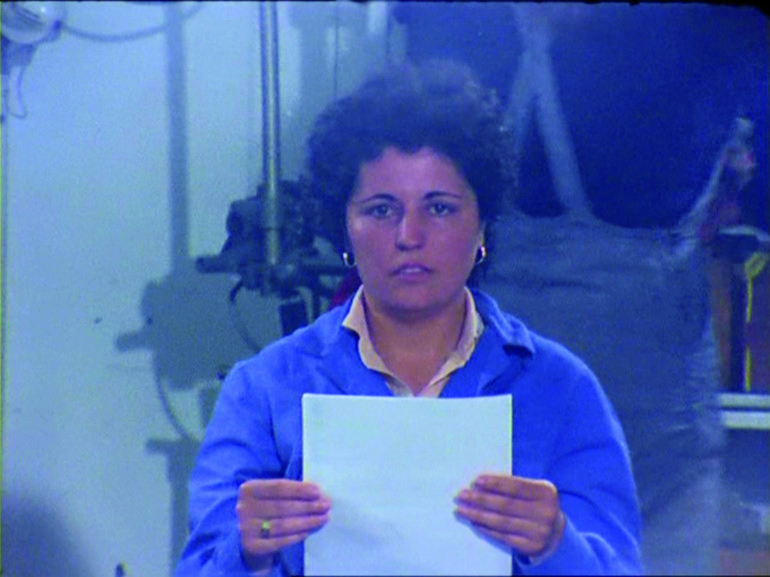
During this interval of interpretative silence or inactivity (approximately between 1979 and 1999), the movie remained associated with an eccentric vision of the working class, hardly adjusted to the representations of labour mobilisations. The hegemonic militancy was deeply related to works by Helena Lumbreras and the Colectivo de cine de clase (Class Cinema Collective). These were the icons of syndicalism. As Jordá would later remember in an interview in 2004, that of the collective was ‘an apotheotic cinema which strengthened heroism. It had two origins: a caricature of Soviet cinema of the twenties, formally very different but copying their spirit; and some drops of a less critical Italian cinema’ (GUERRA, 2005). In contrast, ‘Numax presenta… did not have an apotheotic purpose. […] It passed from the starting euphoria to a tale of dissent’ (Ídem). And according to the filmmaker, ‘at first, the workers start from a goal: they try to keep the worker’s power inside the factory, until a second reflection is imposed. At the end we abandon that simulacrum of power and we go to life’ (Ídem). From that point on, the political management starts to take charge of something more than the economy, the schedules or the labour conditions. It will take charge of life, preparing the field for a militancy, that remembering the courses of the Philosopher Michel Foucault at the beginning of 1979 –just when Numax presenta… is shot –, will have a biopolitical nature.
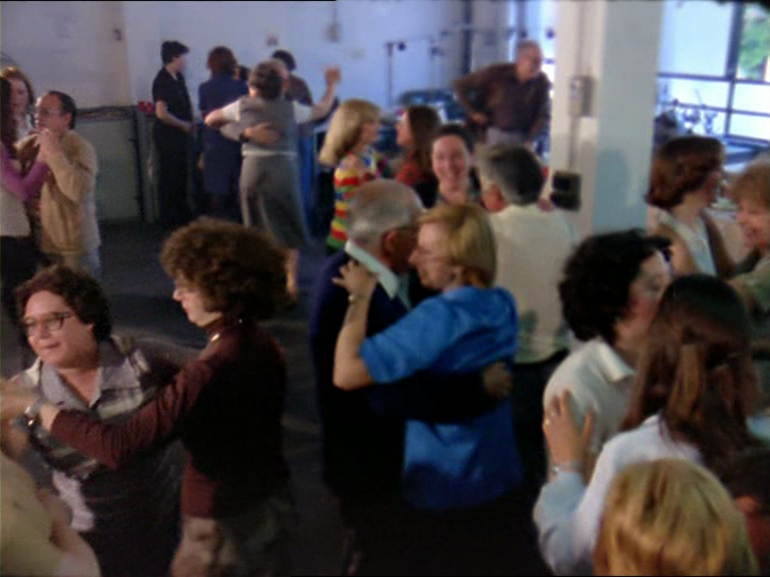
Therefore, in a context where militancy was held in the same structures of the syndicates and the political parties4, the film opens a new scenario concerned for collective pedagogies and the establishment of a collective intelligence. The interests expressed by the workers in the last sequence at the dance, where Jordá with a microphone in his hands surveys each one of the labourers who participated in the movie, suppose a turning point in what a process of demotic deliberation would be, where opinion seemed not to be mediated by the orthodoxy of the political language settled in the agreements of the Pacts of Moncloa (1977) or the newly released constitution (approved in 1978). Until 2004, twenty-five years later, Jordá could not explore the significance of those declarations presented as a group of ideas that were closer to a definition of a lifestyle. As we will see, lifestyle is neither exempted of ideology nor of political agency. Due to the production of the film that resumes the biography of those workers so many years later, Jordá confirms the effects of time. When he finished this film he concluded: ‘they might have not done everything they wanted, but they have not done anything they did not want’. The radical nature of change implied to relinquish every notion of individual progress in favour of labour improvement. And although the camera seems to record minutes of very discrete achievements, Jordá would insist that ‘from the vital point of view they are of an enormous opulence’ (GUERRA, 2005).

Right: Veinte años no es nada (Joaquín Jordá, 2004)
Veinte años no es nada (2004) stages the recuperation of Numax presenta… through an authorial operation that could remind of other examples of the same genre such as Reprise (Hervé le Roux) which in 1997 resumed a film sequence form 19685. However, the maturing conditions that allowed reactivating the original text of Numax presenta… refers to the social scenario of the early 21st century. The Seattle protests against the World Trade Organization radically transformed the language of classic militancy. The implication of the working class would be replaced by the notion of multitude, which implied a more explicit transversal implication among social classes. The scenario changed from events ruled by the mass media and the media event, to the possibility to catalyse the desired occurrence by the new online and connected multitude. Thus, in documentary practices terms, the participation and implication in the events dismantled the politics of truth sustained by the hegemonic mass media, breaking with the tradition of the objectivity based on the distinction between facts and opinion. These three features could by synthetized in the emergence of the postmedia documentary. Its performative character is embodied in Jordá’s work starting from Monkeys like Becky, where the filmmaker’s sickness is assumed as an unavoidable condition. The sick author will turn into a symbol of the perceptive limitations and the adaptation to a production model considerably lessened. The contingency of the documental genre in Jordá’s filmography will be usually determined by the fact that many of his projects were conceived as fictions which ended up as documentaries in response to lack of funding6.
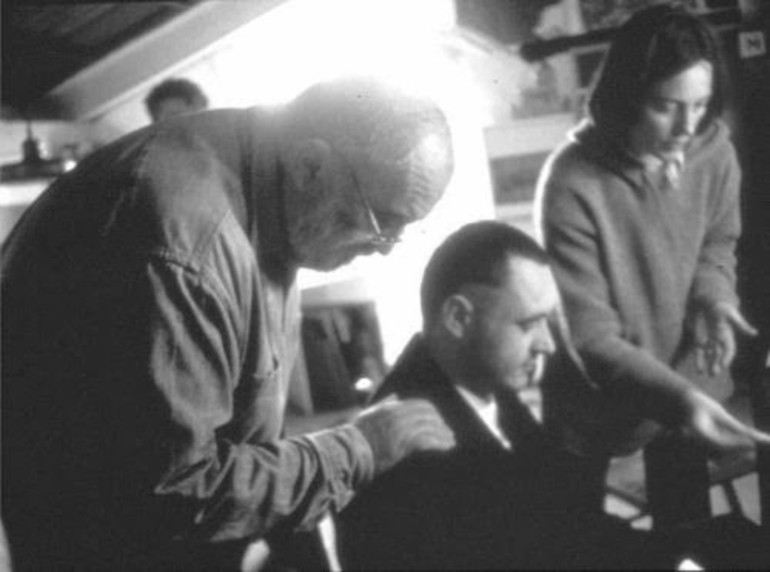
Among the new forms of biopolitical militancy, the critique to the psychiatric institution will encourage a series of projects that will question the welfare politics. Barcelona, the city where Jordá worked most of his life, was at the late nineties a case of study for the governance techniques of the social democracy. The urban condition acquired an incredible importance as scenario and reflection of the relations of those forms of power that aspired to control the population excluding the classical police methods. Social engineering and the reforms in the public space made out of Barcelona an improved scenario of the biopolitical government techniques. In this context social movements supported by neighbourhood councils and assemblies strongly emerged, and furthermore the documentary practices were articulated to the perception of certain urban deep transformations. Between the very acclaimed documentary En construcción (2001) by José Luis Guerin, and the very polemic De nens by Jordá, the urban matter was thoroughly identified with documentary genre. This documentary practice was understood as an extension of certain forms of activism. Therefore Barcelona accomplished an iconic statute as a city that fused the urban critique and the transformation processes. The biopolitical condition captures both the psychological and subjective aspects of the population, together with those apparently external aspects we consider an urban object. Hence, to practice militancy in this background means to break with this distinction.
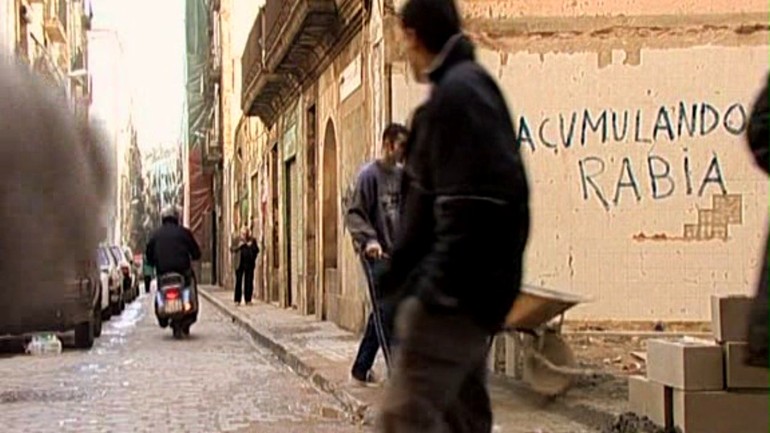
De nens departed from a pederasty case widely covered by the mass media. The Raval affair exploded in 2001 and implicitly a zone of the city turned out stigmatized by the news. In the midst of the urban regeneration of the old China Town, and in the 21st century, Barcelona revives the paradox of the modern hygienism. The moral and physical degradation corresponded to each other as in late 19th Century Paris novels by Émile Zola. To represent this perverse articulation Jordá recorded the trial of the alleged pederasty case. The concentration and assemblage of the police discourses, the psychiatric report and the advice of the departments in charge of childhood protection, produce the referential event for the documentary. The linguistic and communicative nature of this material allows to compare Numax workers with the participants of the trial of the Raval affair. In both cases what is filmed is a linguistic interchange with such a density that it substitutes other events. And although this comparison seems to be outrageous due to the incommensurable nature of the debates they present, the most effective qualities of documentary, as Jordá understood them, are found there. Documentary extrapolates ideological aspects to the point it configures itself as a radically unfinished event.
If what De nens presents can be described as a diffuse device of power supported by a constellation of institutions (urbanism, social services, education, police, medicine, even mass media repeating and spreading their statements), it could be suggested that Jordá’s documentary accounts for that same model of organization. Therefore the documentary practice is constructed as a mirror of this composition. In the same way militant documentary film has been considered as the production of a common place that promotes a scenario for collaborations between producers and spectators (in the case of Numax presenta… the workers associated with the filmmaker in order to make public their experience), it can be understand as the mechanism to interrupt some of those connexions when necessary. Definitively, what is reflected through a documentary produced from a biopolitical perspective is a regime that allows certain discourses to be mutually supported in order to circulate with another one that results being delegitimized. As an example, we find the accused from the Raval affair who could not even speak about themselves. Their voices are expropriated by the puzzle of the institutions of the welfare society. Their own life does not belong to them.
Consequently, and according to what has been said until this point, it is necessary to refer a documentary dispositif to talk about Jordá’s trajectory. The intersection of different specialities, languages and institutions is not confined to the reinforcement of a mechanism of power as revealed in De nens, but it can also make out of documentary a shared shelter for artistic practices, investigations and activism. Thus, documentary is not a synonym of a strictly visual production anymore. In contrast, it broadens its possibilities to the creation of devices, whether they are critical, theatrical, filmic or pedagogic. Let us remember that the work of Jordá has suffered from a certain anomie even inside the institutions that should accept it with no trace of a doubt. As a symptom we find the inclination of museistic institutions to integrate his work in its contents, both the Museu d’Art Contemporani de Barcelona and the Museo Nacional Centro de Arte Reina Sofia have integrated Numax presenta… to the context of their collections, one more example of the drifts of this film. The integration of a determined practice to a film context, the museum or any other place would be part of the capabilities associated with this device. However, the best efficacy of the device has been revealed in those cases where cinema is found, paraphrasing Jacques Rancière, ‘where least expected’.
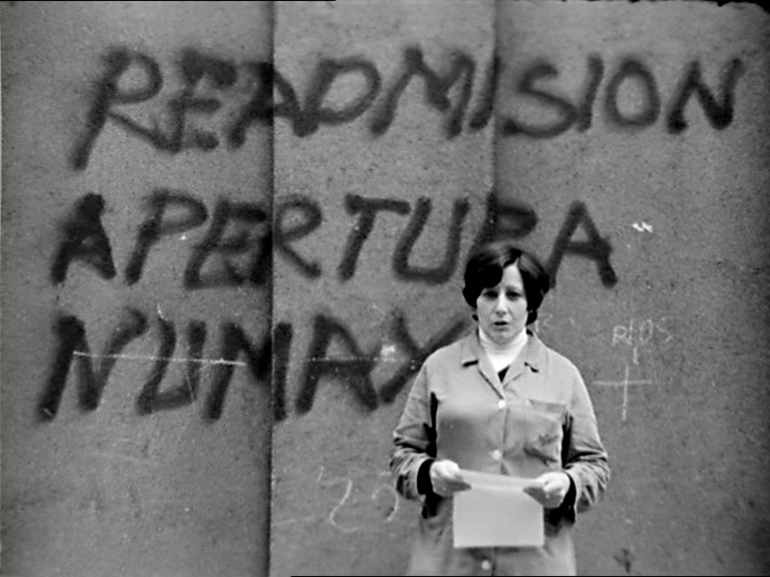
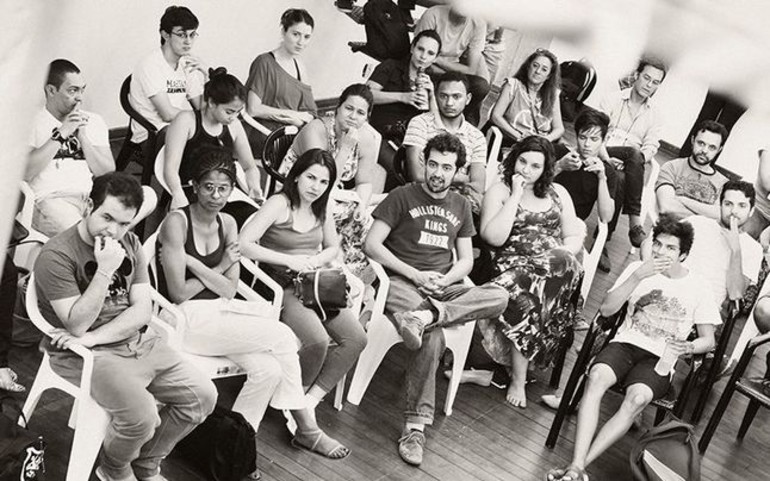
Bottom: Numax-Fagor-Plus (Roger Bernat, 2014)
The relevance of Numax presenta… nowadays, as presented in the staging of Roger Bernat, is based exactly on this effect. Some dialogues pronounced thirty-five years ago sound completely pertinent to these critical moments. The suspicion towards the capital expressed by those workers in the late seventies of the last century is not very different from the deception in which the financial capital has drowned us in the beginning of the 21st Century. The assistants to the representation Numax-Fagor-plus or any other version of this text feel possessed by the dialogues of people they don’t know and they have never spoken to. This is how a historical collaboration between distant times and places that have never had contact is produced. As Bruno Latour would say in one of his latest proposals about new research models, this sense of collectiveness ‘allows insisting on the collection or composition operation, highlighting the heterogeneity of the beings gathered this way’ (LATOUR, 2012: 298). The missions of the documentary dispositif Jordá represents with his work have nothing to do with a strictly cinematographic production. Observing the usages of films such as Numax presenta… and De nens, often exhibited by collectives that find in those texts an expression of their common interests, we can affirm that Jordá produced common platforms of an incredible validity. His movies would not be the reflection of a debate, but rather the creation of common spaces for that debate to be held publicly.
Translated from the Spanish by Carolina Sourdis
ENDNOTES
1 / Some of the remarkable references that have intended a global approximation are: FERRER, J. M. and ROM, Martí (2001). Joaquín Jordá. Barcelona. Cineclub de l’Associació d’Enginyers Industrials de Catalunya; MANRESA, Laia (2006). Joaquín Jordá. La mirada lliure. Barcelona. Filmoteca de Catalunya, ICIC; VIDAL, Núria (ed.) (2006). Joaquín Jordá. Torino. Museo Nazionale del cinema, Fondazione Maria Adriana Prolo and AAVV (2006). Joaquín Jordá. Revista de Cine Nosferatu. San Sebastián. Donostia Kultura.
2 / http://rogerbernat.info/en-gira/numax-fagor-plus/
3 / See the notion of ‘social factory’ in GUERRA, C. (2003). N for Negri: Antonio Negri in conversation with Carles Guerra in Grey Room. Architecture, Media, Arts, Politics. Primavera n. 11. (p. 92). Massachussets. The MIT Press.
4 / Jordá declares in the previously referred interview: ‘There was almost no militant cinema here. If any, it was produced by structures close to the PSUC (Unified Social Party of Catalonia) and the CCOO (worker’s commission). It was an instructive, optimist and triumphalist cinema. It sang glories from the struggle and victorious endings. In contrast, Numax presenta… was not considered an optimistic film, although I think it was, because finally all the characters of Numax were able to liberate themselves from a proletarian condition they had not assumed by will. This is how this movie gained the rejection of the unions, the CCOO and parties such as PSUC. I remember its only screening on the 1st of May. All the people from Numax and the movement went. At the end a very polemic debate was held, there were protests from Numax workers, especially those related to Trotskyism. They did not say the film denigrated the working class, but they did consider the film exalted it somehow. They found the film defeatist. I remember one of the young women who appeared in the film and belonged to the structure of the LCR (Revolutionary Communist League), who is protagonist of the second part as well, using a very usual expression against me: ‘We will hang you with the guts of a bureaucrat’. It was a rhetorical sentence indeed, with no real intentions, but it was accusatory. Simultaneously, Numax presenta was supported by other more realistic sectors. We could say the film was made in a militant context, with a militant structure, but with no militant individuals.’
5 / The sequence of La Reprise du travail aux usines Wonder (IDHEC, 1968) was similarly
6 / Maria Aurèlia Capmany parla d’Un lloc entre els morts (1969) would be an example that anticipated the contingency of the documentary, as the film was intended to be more than a preparation for an adaptation of the homonymous novel. For an excellent revision and inventory of Joaquín Jordá’s unrealized projects see SALVADÓ, G. (2006). Espectros y películas. Los proyectos truncados de Joaquín Jordá. Revista de Cine Nosferatu, (52), pp. 31-39.
ABSTRACT
Joaquín Jordá’s work suffers from a material precariousness that contrasts with an exceptional reception by different collectives, which periodically reinforces the actuality of the films. Beyond its cinematographic qualities, the trajectory of this filmmaker represents the transit between a classic militancy and one of a biopolitical order. The paradigmatic case is Numax presenta... (1979). This militant film broke the patterns in which a labour strike should be narrated, to result as an example of a new productivity model according to postfordist ideas. The discursive intensity of the documentaries by Jordá, endorses a new category of the linguistic and dialogical event that would allow their identification as postmedia documentaries. This kind of documentary practice transforms the debates integrated to the film, into acts of biopolitical militancy. The critique to a social democracy governance regime –which has required the paradigm shift– will be held in further tittles such as Monkeys like Becky (Mones com la Becky, 1999) and De nens (2003).
KEYWORDS
Autonomism, postfordism, biopolitics, social democracy governance, militant cinema, postmedia documentary, documentary practice, documentary dispositif.
BIBLIOGRAPHY
FOUCAULT, Michel (2004). Naissance de la biopolitique. Cours au Collège de France 1978-1979. París. Seuil.
GUERRA, Carles. (2005). Joaquín Jordá entrevistado por Carles Guerra, septiembre de 2004. Agenda informativa del MACBA. Recuperada de: <http://www.macba.cat/es/numax-presenta-2779>
GUERRA, Carles. (2005). Joaquín Jordá ou le cinema de situation, en AA.VV. (2006). Festival International du Documentaire, Marseille. Marsella. FID, pp.129-139.
HEBDIGE, Dick. (1979). Subcultura. El significado del estilo. Barcelona. Paidós.
LATOUR, Bruno. (2012). Enquête sur les modes d’existence. Une anthropologie des modernes. París. La Découverte.
LAZZARATO, Maurizio. (1997). Lavoro immateriale. Forme de vitta e produzione de soggettività. Verona. Ombre Corte.
RIAMBAU, Esteve, TORREIRO, Casimiro. (1999). La escuela de Barcelona. El cine de la gauche divine. Barcelona. Anagrama.
ZUNZUNEGUI, Santos. (2001). Corregir y dirigir, Monos como Becky en CATALÀ, J. M., CERDÁN, J., TORREIRO, C. (ed.), Imagen, memoria y fascinación: notas sobre el documental en España. Madrid: Ocho y medio, libros de cine, Festival de Cine Español de Málaga.
CARLES GUERRA
Carles Guerra is an Associate Professor at Pompeu Fabra University and has taught postmedia documentary practices in the Center for Curatorial Studies at Bard College. Between 2009 and 2011 he directed the Virreina Centre de la Imatge, where he presented projects such as Antiphotojournalism and 1979. Un monumento a instantes radicales. Between 2011 and 2013 he was Chief Curator at the Museu d’Art Contemporani de Barcelona (MACBA). He was a member of the editorial board of the Cultura/s supplement of La Vanguardia journal between 2002 and 2013. In 2006 he curated Cine de situación, a retrospective cycle of Joaquín Jordá in Artleku, MACBA and FID Marseille.
Nº 5 PEDAGOGIES OF THE CREATIVE PROCESS
Editorial. Pedagogies of the Creative Process
Gonzalo de Lucas
DOCUMENTOS
The Goodwill for a Meeting: That's cinema
Excerpts by Henri Langlois, Jean-Louis Commolli, Nicholas Ray
FILMS UNDER DISCUSSION. INTERVIEWS
Filmmaker-spectator, Spectator-filmmaker: José Luis Guerin's Thoughts on his Experience as a Teacher
Alain Bergala
Filmmaker-spectator, Spectator-filmmaker: José Luis Guerin's Thoughts on his Experience as a Teacher
Carolina Sourdis
ARTICLES
In Praise of Love. Cinema en Curs
Núria Aidelman, Laia Colell
A Daring Hypothesis
Jonás Trueba
To Shoot through Emotion, to Show Thought processes. The Montage of Film Fragments in the Creative Process
Gonzalo de Lucas
The Transmission of the Secret. Mikhail Romm in the VGIK
Carlos Muguiro
The Biopolitical Militancy of Joaquín Jordá
Carles Guerra
REVIEWS
AA,VV. BENAVENTE, Fran y SALVADÓ, Glòria (ed.), Poéticas del gesto en el cine europeo contemporáneo.
Marga Carnicé Mur

